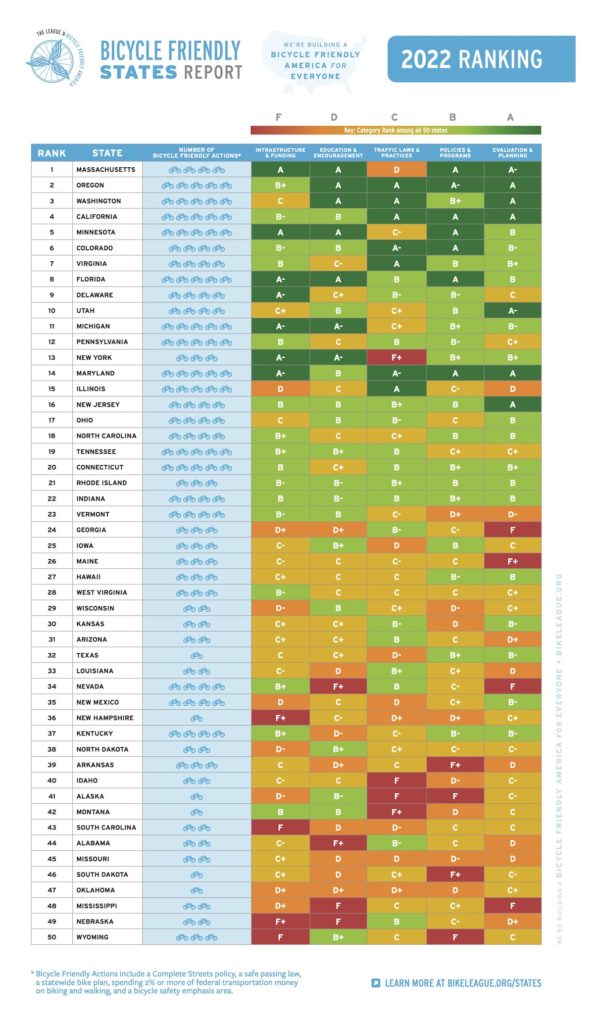There are worse places to bicycle than South Dakota, but not many. The League of American Bicyclists’ new rankings of the states for bike-friendliness place South Dakota 46th for pedalist promotion and policy, ahead of Oklahoma, Mississippi, Nebraska, and Wyoming. Minnesota ranks 5th, a notch better than Colorado and behind only California, Washington, Oregon, and nation-leading Massachusetts.

The Bike League’s state report cards show that South Dakota is actually killing off a slightly smaller percentage of its cyclists than Minnesota: South Dakota’s fatality rate for bike commuters is 2.9 per 10,000, the 4th-lowest rate in the nation, versus Minnesota’s 3.1 per 10,000, 6th lowest in the nation. Nebraska ranks 5th on that metric at 3.0 per 10K. Oregon has the lowest fatality rate at 1.7 per 10K bike commuters; Mississippi is the most dangerous state to ride, with 35.6 fatalities per 10K riders.
Of course, there aren’t that many bike commuters to mow down with your pickup truck in either state. In both South Dakota and Minnesota, less than 1% of commuters bicycle to work. Oregon ranks first in bike commuting, but even there, only 1.98% of commuters are pedaling to work. Montana, Colorado, and Wyoming are the only other states with more than 1% of commuters taking bikes to work. Mississippi has the lowest rate of bike commuting, with just 0.08% of its commuters getting to work by their own pedal power. (Hmm: the state with the highest percentage of bike commuters has the lowest cyclist fatality rate, and the state with the lowest percentage of bike commuters has the highest cyclist fatality rate.)
South Dakota has a safe-passing law, enacted in 2015, requiring motorists to give bicyclists 3-foot berth when passing on roads with speed limits up to 35 miles per hour and 6-foot berth on faster roads. But that’s the only one of five bike-friendly actions the Bike League spotlights. Minnesota has a safe-passing law plus a “Complete Streets” policy, a statewide bike plan, and an emphasis on bicycle safety in its strategic highway safety plan, and Minnesota spends at least 2% of its federal transportation funds on bicycle and pedestrian infrastructure.
We have a friend who was riding his road bike in Boulder Canyon and was knocked off his bike by a passing car or truck. The driver did not stop maybe due to distracted driving and did not even realize he/she hit the cyclist. Or thought cyclists have no business riding the road. He was very fortunate not to have died and only had minor injuries. I don’t see much hope for safe cycling in SD unless you’re on a paved road in the middle of nowhere. Safe bike lanes in Sioux Falls?! How would that work for narrow roads like 26th, 18th streets? Or Minnesota Ave, 33rd, 41st and on and on.
Bike lanes integrated with roads are dangerous imo. I hate driving in places like Boulder, especially making right turns across bike lanes.
They’re just too close to car traffic.
SD DOT, Tourism, and even GFP and the counties need to wake up that bike commuting and tourism is a thing.
The largest single day recreation event on the Black Hills National Forest is . . . the Dakota Five-0. Organizers cap it at 700. The event is over Labor Day weekend. Spearfish created a “bike week” leading up to it. It draws people from 10+ states and provinces. It sells out in minutes through its April on-line registration. (The Mickelson marathon has more participants . . . but its held on state jurisdiction, not Forest Service turf. SD’s Mickelson Trail Trek caps at 650 and similarly sells out in days.) The longest running recreation event on the Black Hills is the Sundance-sponsored Bear Lodge Mountain Classic – a bike race. Bikes became prominent in the mining camps. Bikes were less expensive than horses. The US Army conducted a bike vs horse exercise from Fort Meade to Morecroft, WY (and with a side trip to the Bear Lodge Mountains). The bicycle troops out performed the horse cavalry – in 1904, without the benefit of I-90 and its service roads.
SD DOT ought to link Spearfish to the Mickelson Trail – either through the canyon or through Maitland Road to Lead. Spearfish Canyon is a “no-brainer” since South Dakota holds a variable TITLED right-of-way (gifted by Homestake). Additionally thousands run and bike the canyon on its narrow, almost no shoulder road.
There is no excuse for FSD, RAP, BKG, Vermillion to not have sustainable bike traffic. There is no excuse for not having one or the other 1804 or 1806 byway being bike-able and the other being open to UTVs.